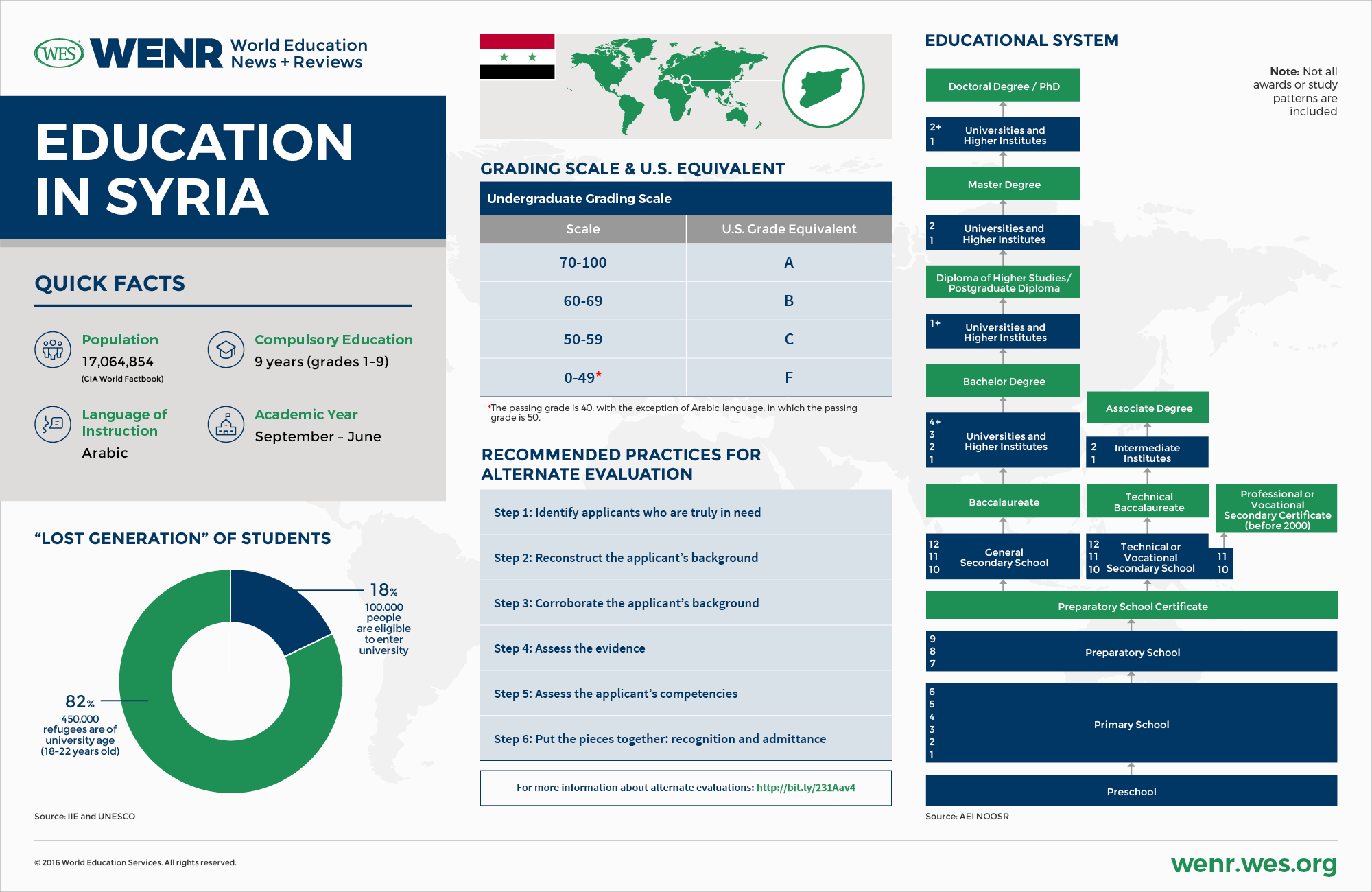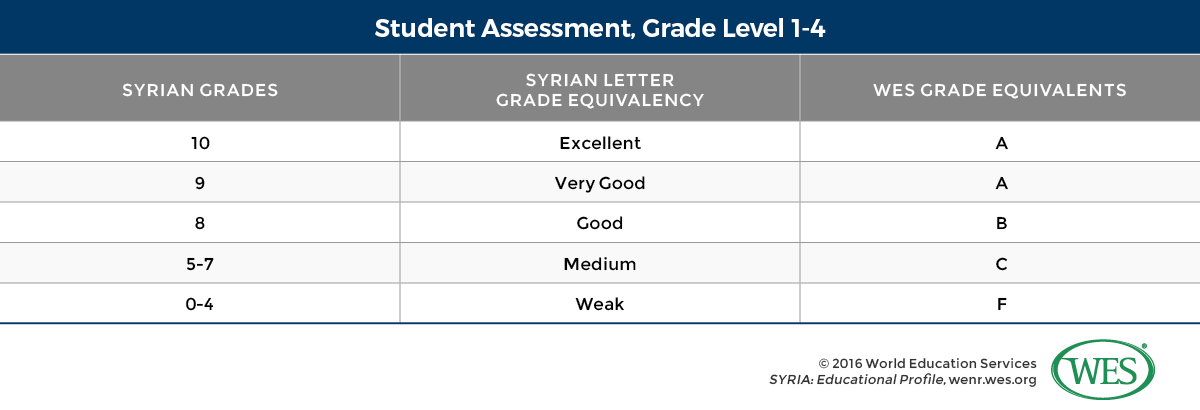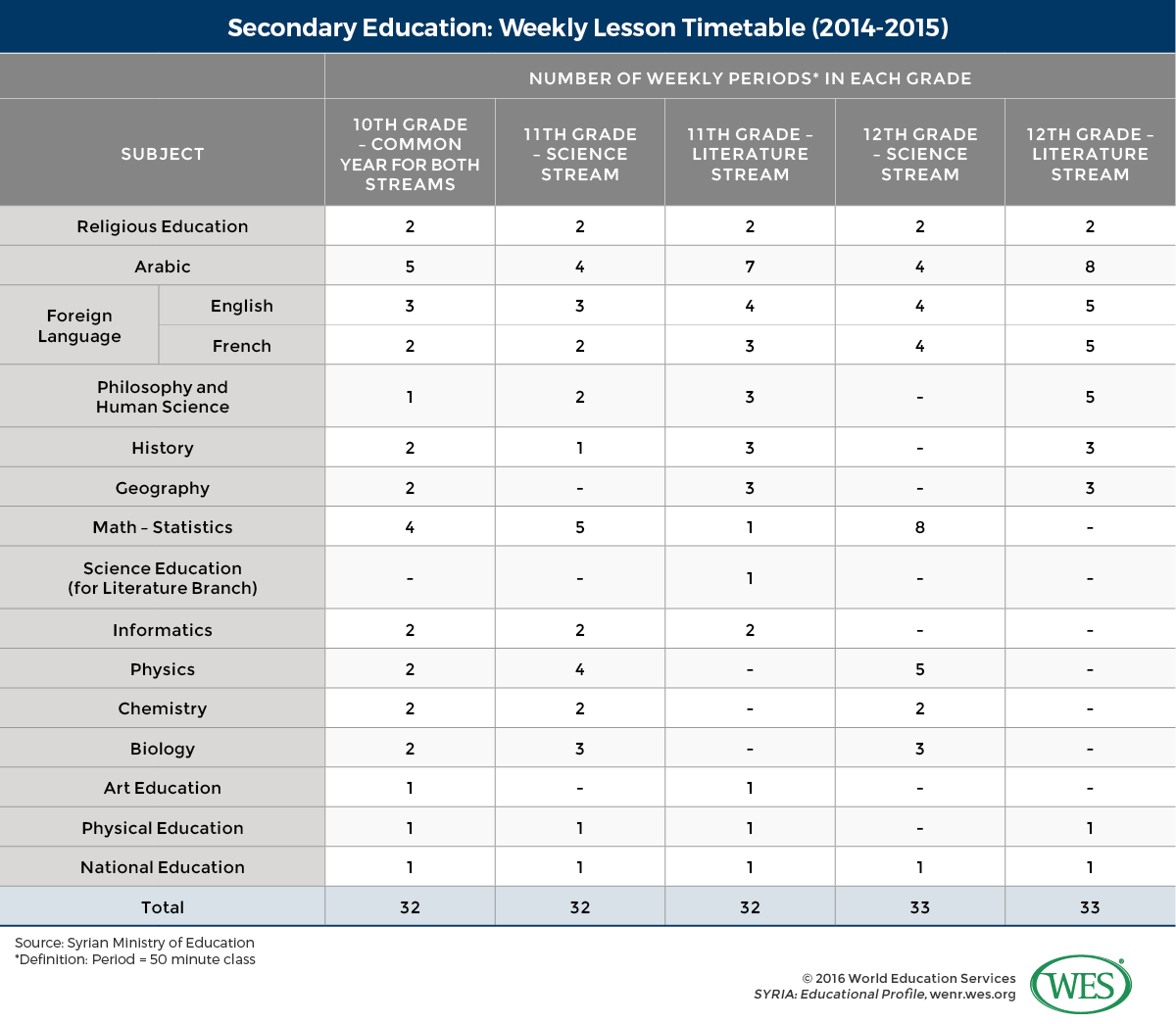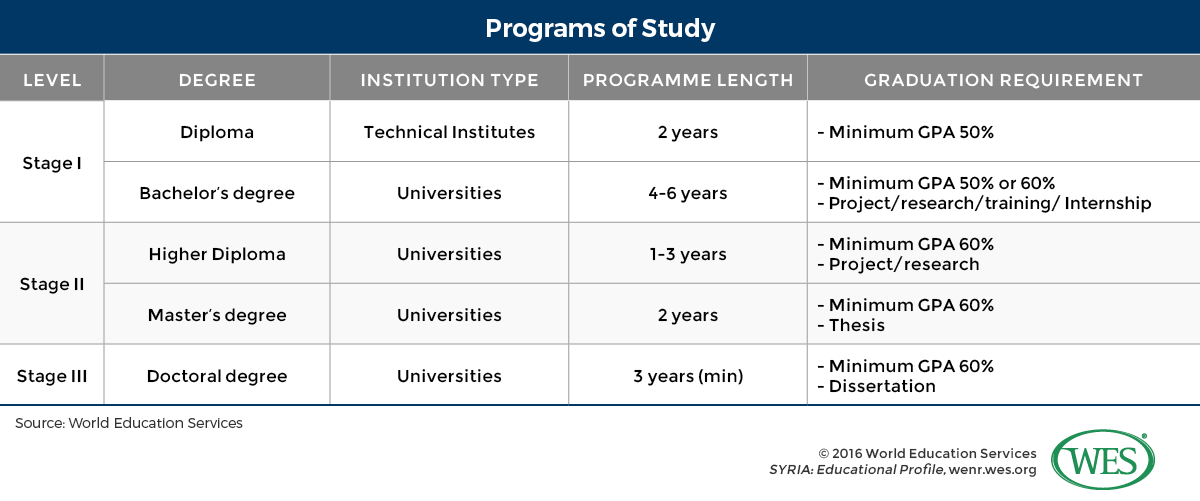Silje Immerstein, Training Manager and Sulaf Al-Shaikhly, QA Manager
Education Overview
The Education System in Syria
Administration and Finance
In 2009, 5.1 percent of Syria’s GDP was allocated to education. The Syrian government plays a central role in the administration, planning, and supervision of education in the country.
The Syrian Ministry of Education supervises basic and secondary education, including private schools, and is directly responsible for curriculum and learning materials. The Ministry oversees education policy based on the ruling party’s resolutions and regulations.
Higher education is governed by the Ministry of Higher Education, which is also responsible for developing, deciding, implementing, and evaluating higher education policies, laws, and regulations.
All public basic and secondary education is free and funded by the government. Public higher education is also free; however, fees may be charged in some cases. (For example, students who graduate with low secondary school scores can pay a fee to access certain higher education programs.) Private institutions do not receive government financial support.
Size of the School System in Syria
In 2014, there were approximately 2,553,000 students enrolled in basic education and 2,875,000 enrolled in secondary education. Prior to the start of the ongoing conflict, basic education enrollment was close to 93 percent. In 2015, an estimated 2 million Syrian children were out of school in Syria; roughly 5,000 schools could not be used because they had either been destroyed or damaged by the war.
In the 2012/2013 academic year, there were approximately 659,394 students enrolled in public and private higher education institutions throughout Syria. The war has displaced university-age Syrians (18-22 years old) in significant numbers. In 2015, the Institute of International Education (IIE) estimated [2] that some 450,000 university-age Syrians had become refugees; about 100,000 are believed to be qualified for enrollment in universities. (Read more about Syria’s so-called “lost generation” of students in the December 2015 issue of World Education News and Reviews here [3].)
Structure
Pre-primary education is available for children aged three to five. It is not compulsory and is provided on a fee-paying basis. Most pre-primary education schools are privately owned and operated. Grassroots organizations are encouraged to establish schools to help increase pre-primary education offerings.
Syria follows a 12-year system of basic and secondary education, consisting of nine years of basic education and three years of secondary education. Basic education (grades 1-9) is mandatory and is divided into two cycles. The first cycle is four years; the second is five.
Secondary education is offered in three-year general secondary schools and in three-year technical/vocational schools.
Higher education in Syria is offered at the following types of institutions and in the following numbers:
- 201 technical/intermediate institutes
- 20 private universities
- 7 public universities
- 6 higher institutes (Higher institutes are public institutions that are supervised by the Ministry of Higher Education. Several are also under the supervision of the Damascus University. The institutes are considered by the Ministry to be centers of excellence. They offer diplomas and degrees up to the doctoral level. Entry requirements are higher than for public universities.)
Private and Public Education
Ninety-seven percent of basic education schools are public, while only three percent are private. Ninety-four percent of secondary schools are public; six percent are private.
The Syrian government authorized the privatization of higher education in 2001. There are currently 20 private and seven public universities in Syria.
Academic Year
At the basic and secondary levels, the academic year runs from September to June. The higher education academic year runs from October to June and is divided into two semesters.
Language of Instruction
Arabic (Some higher education programs are in French and English.)
Teacher Education
Teacher training is a priority of the Ministry of Education. The Ministry provides continuing education to improve teachers’ competencies and performance on an ongoing basis. At the local level, education directorates in the various provinces (governorates) use classroom observations to monitor and assess teacher performance; they also provide teachers with guidance from education specialists.
Prior to 1999, teachers of preparatory school (roughly equivalent to today’s second cycle of basic education) and technical/vocational secondary teachers earned their teaching certificates by completing a two-year post-secondary program at an intermediate institute. From 1999 until the present day, education for these teachers has been offered by the faculties of education at universities.
Teachers at all levels are required to complete a four-year bachelor’s degree, which addresses teaching methodologies, subject specialization, and practical training. Graduates are awarded bachelor’s degrees in education, which allow them to teach up to the twelfth grade. Prospective teachers who hold bachelor’s degrees in other fields can complete a one-year post-graduate program leading to a teaching certificate called a Qualifying Diploma in Education.
A master’s degree or Ph.D. is required to teach at the university level.
Basic Education
Age of Admission
Age six
Length
Nine years, divided into a first cycle (four years), and a second cycle (five years).
General Information
The Ministry of Education is the primary governing body for basic education, which runs from grades 1-9 (ages 6 to 15). Basic education is compulsory and free.
Program of Study
The curriculum is set by the Ministry of Education and includes the following subjects:
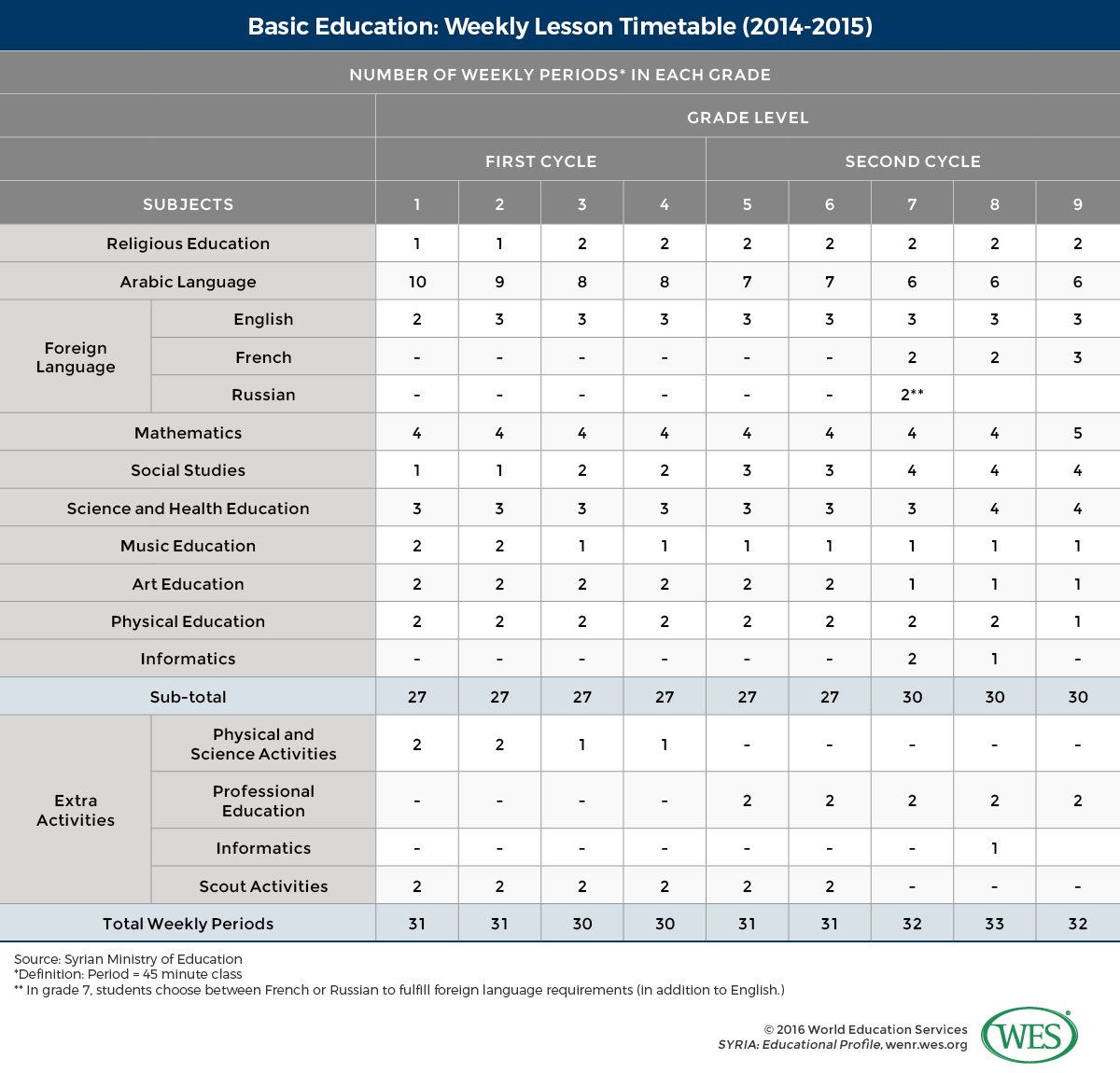 [5]
[5]
Assessment and Promotion
At the end of the basic education cycle, students take a national exam. Those who pass are awarded the Basic Education Certificate (Shahadet Al-Taleem Al-Asasi). The students’ test results determine if they are entitled to attend general secondary schools or vocational/technical secondary schools.
Grading Scale
Secondary Education
Age of Admission
Age 16
Length
Three years
Admission Requirements
All students who pass the national exam at the end of basic education qualify for secondary education. However, students’ test results determine whether they qualify for general/academic secondary schools or vocational/technical secondary schools.
In 2012, 57 percent [8] of students continued on to secondary school, down from 98 percent the previous year. Of those, 23 percent enrolled in technical/vocational schools.”
Structure
The Ministry of Education is the primary governing body for secondary schools.
Secondary education lasts three years and is offered at general/academic secondary schools and technical/vocational schools. Students attend secondary schools from grades 10-12 (ages 16-18). Secondary education is not compulsory.
General/Academic Branch
All students pursuing the general/academic branch follow the same curriculum in grade 10. After that they must choose between two academic streams:
- Science: Biology, chemistry, informatics, logic and humanities, math, and physics
- Literature: Arabic society (including principles of economics and general philosophy,) art, geography, and statistics
Students who complete the general/academic branch and pass a national qualifying exam are eligible for higher education at universities or higher institutes. Students who scored low on the national exam have the opportunity to retake the exam once in order to qualify.
Technical/Vocational Branch
Students pursuing the technical/vocational branch choose between the following specializations:
- Commercial: Accounting, administration, advertising, book-keeping, commercial law, computing, economics, financial math, secretarial skills, statistics, and tax
- Feminine Arts: Carpet-making, childcare, clothing and textiles, dressmaking, embroidery, and home economics
- Industrial: Computing, circuitry, electronics, television and radio, satellite maintenance (TV), and video recorders
Graduates of technical/vocational secondary schools can choose to start employment immediately or to continue onto two-year technical institutes (also referred to as intermediate institutes) where they can work towards an associate degree.
Graduation Requirements
Both secondary school branches end with a national exam administered by the Ministry of Education, and all students who pass – regardless of branch – are awarded a general secondary education certificate, which is equivalent to a high school diploma in the U.S. and Canada. Diplomas have different names depending on the subject area (i.e., General Secondary Education Certificate, Industrial Secondary School Diploma, Secondary School of Commerce Diploma). Students who do not pass the national exam have the opportunity to retake it one time.
Program of Study
The Ministry of Education sets all curricula at the secondary level; depending on the track, curricula are consistent across schools.
Common Courses
Common courses in the academic branch (science and literature streams) include:
In addition to the common courses, students are required to take courses that apply specifically to their chosen stream within the general/academic branch.
Common courses for the vocational branch are unknown.
Assessment and Promotion
Students have to pass all courses in order to continue to the next grade level. Final secondary education grades are based on a student’s score on the national education exam at the end of the final year.
Grading Scale
Higher Education
Access
The Ministry of Higher Education oversees the higher education sector in Syria. By law, holders of a general secondary school certificate qualify for access to higher education.
Admission Requirements
Admission into higher education is highly competitive. Although all students with a general secondary school certificate are guaranteed admission to higher education, the institution to which they are admitted depends on the scores they receive on the secondary-school examination.
Grades from previous years of secondary school are not factored into admissions. Instead, a centralized University Admissions Committee within the Ministry of Education determines how students will be distributed, factoring in both examination results and student preferences. Students typically select programs that correspond to their upper-secondary specialization; for instance, students who pursue the science track at the secondary level might select an engineering program at the tertiary level, while students who pursue the humanities track might continue on in a humanities program at the tertiary level.
Recognition/Accreditation
Because institutions of higher education cannot operate without government approval, all operating institutions are assumed to have formal recognition or accreditation. A list of recognized higher education institutions (in Arabic) can be found at mohe.gov.sy/mohe [11].
Length
Length is dependent on program type:
- Associate degrees require two years.
- Bachelor’s degrees typically require four years. (Some disciplines require additional years.)
- Master’s degrees require two years, although extensions are available.
- Doctoral degrees require a minimum of three years.
Intermediate studies are offered at technical/intermediate institutes. These institutes offer specialization in a variety of fields: industry, agriculture, technology, administration, economics, business, teacher training for basic and lower level secondary education, transportation, tourism, and more. The programs are typically two years in length, and students are awarded an associate degree (diploma or musaed mujaz) upon completion. To graduate, students are required to have a minimum GPA of 50 percent. Top performing students are eligible to apply for a bachelor’s program.
Undergraduate degrees are typically four years in length with some variation. Programs such as architecture, engineering, dentistry, pharmacy, and veterinary studies require five years; medicine requires six years. Most undergraduate programs start with an introductory year before students choose a specific field of study. Most programs follow a set curriculum with no electives. Students need to achieve a minimum GPA of 50 percent (sometimes 60 percent, depending on the program) in order to graduate. Students are awarded a bachelor’s degree upon completion (al-Ijaaza in Arabic, and license in French).
Master’s programs typically require two years to complete. Master’s degrees are either academic or professional in nature. Those who follow the academic track are eligible to continue on to a doctorate degree. A minimum GPA of 60 percent is required to graduate.
Doctoral programs require a minimum of three years of study after a completed master’s degree. The dissertation is evaluated by an external panel, which includes at least one overseas academic. A minimum GPA of 60 percent is required to graduate.
Assessment and Promotion
Students are assessed based on their performance in the final semester exam. Master’s programs typically require the completion of a thesis in addition to the final exam. Completion of an internship may also be required depending on the program of study.
In order to progress from one academic year to the next, students cannot fail in more than four subjects. Students who fail more than four subjects are required to retake those subjects before they can advance.
Grading Scale
The passing grade is 50, sometimes 60, depending on the program of study. (See the preceding section)
Grade-by-Grade Comparison
Please note: Comparative statements made here are generic, based on comparisons between Syrian education systems and those in the U.S. For specific and individualized evaluation reports, please contact WES (wes.org).
The guidelines below are nonbinding and intended only to assist high schools. The ultimate responsibility for making a placement decision with respect to a particular student rests with the receiving high school. (Please see the “Program of Study” description in the “Secondary Education” section for additional guidance awarding high school credits.)
 [16] Sample Documents: Syria
[16] Sample Documents: Syria
This file [16] of Sample Documents (pdf) shows the following set of annotated credentials from the Syrian education system:
- Aleppo University – Bachelor of Pharmacy Transcript
- Aleppo University – Bachelor of Pharmacy Degree Certificate
- Aleppo University – Envelope
- Damascus University – Bachelor of Informatics Engineering Transcript
- Damascus University – Bachelor of Informatics Engineering Degree Certificate
- Damascus University – Envelope
Additional Resources
Education System and Background
- Education System Syria, NUFFIC [17]
- World Data on Education – 2010/11
- Higher Education in Syria, European Commission [18]
- Country Education Profiles, Australian Government, Department of Education and Training [19]
Statistics
- The World Factbook – Syria Country Profile, CIA [20]
- Syria Overview, Education Policy and Data Center (EPDC) [21]
- Country Profiles: Syrian Arab Republic, UNESCO Institute for Statistics [22]
Syrian Government Pages (Arabic)
- Central Bureau of Statistics [23]
- Guide to the System of Higher Education, Ministry of Higher Education [24]
- Number of Basic Education Schools by City – 2006-2010, Central Bureau of Statistics [25]
- Internal Regulations for Basic Education Schools (Chapter 6), Ministry of Education [26]
- The Ministry’s Announcement for the Start of the School Year 2014-2015, Ministry of Education [27]
Education for Syrian Refugees
- Regional Report: On Out-of-School Children, UNICEF [28]
- Helping Immigrant Students to Succeed at School – and Beyond, OECD [29]
- Access To Education For Syrian Refugee Children And Youth In Jordan Host Communities, UNICEF [30]
- Scaling Up Quality Education Provision for Syrian Children and Children in Vulnerable Host Communities, UNICEF [31]
- Curriculum, Accreditation and Certification for Syrian Children in Syria, Turkey, Lebanon, Jordan, Iraq and Egypt, UNICEF [32]
- Field Study on the Effects of the Syrian Struggle on the Community – Study on Syrian Student Refugees in Lebanon, Democratic Republic Studies Center [33]
- Uncounted and Unacknowledged: Syria’s Refugee University Students and Academics in Jordan, UC Davis, Human Rights Initiative and the Institute for International Education (IIE) [34]


